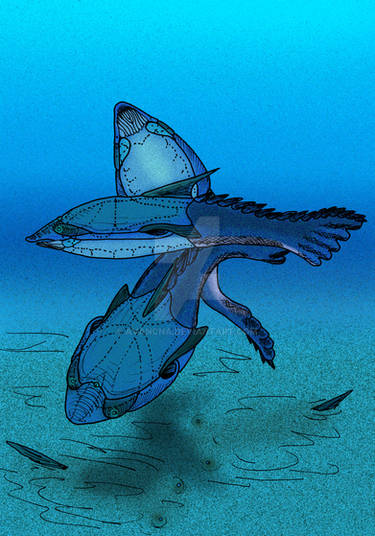Deviation Actions
Description
above: the tortornca, (Tortornca horribilis, a simplified name translating extremely loosely as "horrible, turtle-like bird-orca"), here pictured pursuing a dolfinch, is the largest living burdle. Growing to a length of up to 30 feet, it is a ferocious, solitary, and highly active predator that feeds primarily on other marine birds and molodonts. With a highly streamlined body, it chases its prey down with great agility and over very long distance, relying on endurance rather than a sudden burst of speed, with alternating pulses of its fore and hind flippers, catching exhausted bumblets, sea mittens and other hapless marine creatures in its powerful crushing jaws. No longer tied to the land to breed, it has become larger than any burdle before it and weighs up to six tons.
~~~
265 million years PE, the world of Serina is changing. Ice caps are spreading over the land, pushing terrestrial ecosystems to the margins. Countless life forms on land have already gone and continue to go extinct, unable to adapt to such rapid changes. Yet in the sea, things are changing in a very different way.
Glaciation and the spread of the polar ice caps has resulted in a global sea level drop of significant proportion, on top of Serina's already shallow global ocean. A cold current circulating around the equator, propelled by the meeting of opposing polar winds, keeps these shallow waters across the world churned up. By constantly disturbing the sediment and releasing its stored nutrients into the water column, the result is a very productive, well-oxygenated and nutrient rich environment highly conducive to aquatic life. It is so that Serina's oceans going into the middle Ultimocene are still much less negatively affected by the cooling climate than the land; though biodiversity is lower than several million years ago as a result of the extinction of tropical reefs, the total biomass of fish and aquatic life in the sea is now higher than it has been since the Cryocene - the last time that it was in a similarly productive state, also caused by cool global temperatures.
Cold and fertile waters support huge quantities of phytoplankton, in turn fed upon by swarms of marine crustaceans and baitfish which themselves provide a source o food for a wide diversity of aquatic birds. Most of these organisms, though highly derived, still have close relatives still eking out a living on the chilling land, including sea mittens (related to the neckbeards and their descendants), and dolfinches (distant relatives of the gravedigger). But one group of surviving aquatic birds no longer has any terrestrial relatives at all. The last mucks - the distant and extraordinarily unique descendants of the serestrider aardgeese of so long ago - are entirely aquatic, their last land-living kin having expired with the freezing of the tropical rainforests in the past ten million years. They are the burdles, and as time goes on they have only become every more aberrant. More than 160 million years ago their tall, tree-browsing ancestors lost their feathered plumage for a scaled pelage, their slowed metabolism and the tropical global climate of that era making insulation redundant. Even as the mucks reduced in size and left the ground to scale the branches they never redeveloped this lost feature, retaining their cold-blooded nature and becoming almost reptilian - a first among birds. Mucks survived the devastating Thermocene-Pangeacene extinction as a single species of semi-aquatic, lizard-like omnivore and then radiated back onto both land and sea in the Pangeacene. Yet their time on land was limited, and secondarily terrestrial species never regained former diversity. The future of this lineage was in the water, where today the aquatic mucks in the form of burdles are still thriving even in a rapidly changing world.
Burdles began as omnivores, sampling a variety of diets and consuming nearly anything organic, a generalist habit which let them eke through the end of the Thermocene. Specialization occurred in the Pangeacene, producing large herbivores that have since died out. Their most impressive forms today are very different: active, fierce, reptilian-looking carnivores which truly push the limits for what can still be considered a bird. Some of the most derived of any to evolve on Serina, the predator burdles will be the last of the mucks. But far from a clade dying out with a whimper, this bookend of evolution contains some of the most fearsome predators ever to evolve.
Continue reading on the Serina site: sites.google.com/site/worldofs…
the last line of serestriders turelly has become something unique






















![Liopleurodon[GIF]](https://images-wixmp-ed30a86b8c4ca887773594c2.wixmp.com/f/f02ac9de-5732-48ad-9287-65db7ffd1c1d/d8nafyg-09da0be3-3691-4ecd-b2b9-b9bd2f8196fc.gif/v1/crop/w_184)










